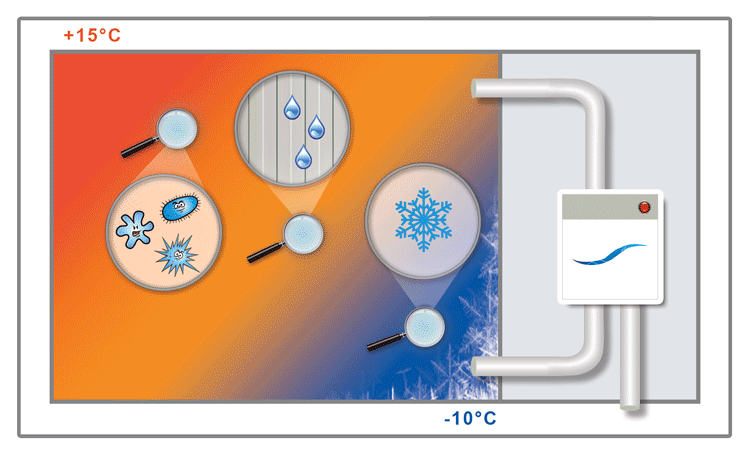Where To Place A Dehumidifier? [Info + Advice + FAQs] 2023
Is your home or office humid? Are you looking for a solution? If so, a dehumidifier may be perfect for you! A dehumidifier is an appliance used to remove excess moisture from a room. Home appliances such as this one are commonly used in living rooms, laundry room, bedrooms, and kitchens. The house dehumidifier can be bought at most stores.
It is essential to know the features of a dehumidifier before buying one to choose the correct one for your needs. Rooms can be dehumidified by using dehumidifiers. This device cools the warm air to eliminate excess moisture. This can help you breathe better and protect your furniture. Furthermore, because dehumidifiers are energy-efficient, they can lower your electric bill.

Where To Place A Dehumidifier?
Dehumidifiers are highly efficient because it depends largely upon where they are placed. Place them close to water in an ideal position to increase their effectiveness. Its important to keep your HVAC system (Heating, Ventilation, and Air Conditioning) in your mind when placing dehumidifier.
Can a dehumidifier be placed anywhere?
Dehumidifiers can be placed anywhere in a room, but they work better in areas with good air circulation. If you want your machine to work efficiently, you should place it in an area with good air circulation.
You might think the basement would be the best place to keep it, since it has the highest humidity. Or maybe you think that airing out the living room will help to reduce moisture levels. But before you make any decisions, be sure to consider the Dehumidifier’s capabilities and limitations.
A dehumidifier is a machine that helps remove moisture from the air. So that the unit can operate effectively, it can be placed anywhere with good air circulation. The best place to place a dehumidifier is in an area with good air circulation. Good place always matters.
Where To Place A Dehumidifier?
It is important to consider the source of moisture when determining where to place a dehumidifier. It is recommended to place the dehumidifier near the source of moisture.
As a result, the amount of moisture in the air will decrease. Some room dehumidifiers can be placed on the floor or in a basement, while other models require a more central location like an attic or living room.
It is essential to consider the climate where you live since different rooms will need different levels of humidity control. They can help reduce the number of illnesses caused by moisture in the air and save you money on your utility bill.
Should a dehumidifier be placed high or low?
A dehumidifier placed low will work better because it can circulate more air and reach a larger area. A dehumidifier placed high will work better in dry rooms, while a dehumidifier placed low will work better in humid spaces.
Some factors that may influence this decision include the height of the unit and whether or not there is a ceiling fan or exhaust fan in the room. A temperature range of 40 to 50 degrees Fahrenheit is ideal for maximum output of a dehumidifier.
High humidity can cause several problems, from mould growth to damage to wood surfaces. A dehumidifier that is placed lower will work better because it will be able to reach the lower levels of humidity in the home more efficiently.
Do You Need A Dehumidifier In Every Room?
Most homeowners can get by with only one or two dehumidifiers to keep their rooms comfortable and dry. The size of the room, the high humidity level and the price are all crucial factors to consider when purchasing a dehumidifier.
However, if you have a large home or live in a humid climate, buying a dehumidifier for every room may be necessary. This is because not all rooms can expel moisture from the air using just the standard ventilation system. Dehumidifiers can be a little pricey, but they can save you on energy bills over time. Air filters can also be used.
Does a dehumidifier have to be in the middle of the room?
Many believe that a dehumidifier must be placed in the middle of a room to work effectively. However, this is not always the case. Placing a dehumidifier near the source of moisture is ideal for larger rooms. Smaller rooms can benefit from a central placement as long as the unit is close to any potential water sources.
Dehumidifier placement for bathrooms
It is advisable to use a humidifier to combat the humidity that’s created when the air is damp. The dehumidifier must be installed immediately when the water gets warm from the bathroom.
A lengthy hot shower can raise the temperature of water in a bathroom. When you take a chilly hot steam bath you will notice that steam in the air consists largely of tiny water drops that are scattered.
When moisture in a room is exposed to cold water, condensation will occur in the toilet. Condensation creates perfect habitats for mold growth and mildew to develop in bathrooms. The worse of the two is condensation, which leaves stains on walls and wood rotting.
Dehumidifier placement for living rooms
The room in question can have a difficult layout involving the dehumidifier. Living rooms are typically the biggest room in your house and it would be best if the whole house dehumidifier was in front of the room.
If you are using your dehumidification unit in the room, keep in mind where your moisture comes in. The front door to the home provides a source of moisture that can occur easily. Humid exterior air is trapped in and carries moisture into your home. It’s possible to install the dehumidifier in front of an entryway for maximum efficiency.
Dehumidifier placement for kitchens
A big mobile portable dehumidifier in the center of the kitchen occupies some valuable room. In addition to providing constant moisture to the house, kitchens also provide heat. Although cooking surfaces can certainly bring humidity others like dishwashers, refrigerators and cooking stoves can also bring unneeded humidity.
Determine where the damp air in your home is coming from by using the dehumidifiers. In the kitchen sinks for example a dehumidifier should be placed beside the sink. If you have a dry kitchen that needs rehydration, you can also use a dryer near the stove that helps keep it cool and dry while cooking. When putting your dehumidifier on, remember that maintaining air flow is crucial.
Dehumidifier placement for crawl spaces
Crawl areas have the least noticeable and most unassuming places, and are capable of containing the most moisture. High humidity can be observed at crawlspace during the hot seasons whereas the outside temperatures are lower than inside.
When cold, wet air enters your cold crawl spaces, condensation can form. When warm air holds less moisture than cooler air, humidity levels rise. A broken pipe or faulty insulation could cause a lot more humidity levels in your crawlspace. Because of the tight space, the dehumidifier is typically less compact than most other dehumidifiers.
Dehumidifier Placement in basements
Place the dehumidifier near the electrical outlet in basement. High moisture levels are common in basements. Because basement walls are underground, water seepage can occur from inside. Many basements do not have adequate ventilation. Many humidifying devices are found inside basements, such as washers and water heater units.
The humidity may increase slowly even when moist air cannot be forced out. Fortunately, dehumidifiers work well in most households to keep moisture away from the basement. Since basements are generally small enclosed spaces, there is usually no difficulty controlling excess humidity inside a large room.
FAQs: Where to place a humidifier?
When should you not use a dehumidifier?
Dehumidifiers can help lower indoor humidity levels but should not be used in temperatures below 60 degrees Fahrenheit. When the temperature is below freezing, condensation will form on the unit and could fall onto nearby electrical equipment, causing a short circuit. Also, mould and other excessive moisture-based diseases can thrive when the relative humidity levels are too low.
Should a dehumidifier run all the time?
Continuous operation of the dehumidifier is not necessary. A dehumidifier should be run for a specific amount of time, usually 24 hours, and then it can be turned off. If you live in an area that is regularly below the Dehumidifier’s maximum capacity, it may be necessary to run it more often.
Air is dehumidified by dehydrating it. Moist air can come from the perspective or from objects that have absorbed water. The Dehumidifier runs when it detects moisture in the air. However, if the Dehumidifier does not see enough humidity in the air, it may need to be run more frequently.
What Level Should A Dehumidifier Be Set At?
Dehumidifiers should generally be set between 30 and 50 percent of their capacity to control excess humidity levels effectively. You may feel comfortable or uncomfortable depending on the relative humidity in your home. Too much moisture can condense windows, cracked ceilings, ceilings, and walls, mould growth, and cause widespread pain.
Moisture is removed from the air by right dehumidifier, thereby reducing the relative humidity level. Dehumidifiers come in various prices and capacities, so it is essential to know what level to set them at for the best results. Tip: Try to not use extension cord. Also connect your dehumidifier to your HVAC system.
Where should you not put a humidifier?
A humidifier adds moisture to the surrounding, which might help with dry skin, allergies, and other respiratory issues. However, there are certain places where you should not put a humidifier.
– It’s important to keep them away from water sources like sinks or tubs and open flames like fireplaces or gas stoves.
– Additionally, it’s best to avoid putting humidifiers in enclosed spaces such as closets or drawers, as it can increase the risk of mold or mildew growth.
– Place your humidifier at least 3 feet away from furniture and bedding if possible.
– Lastly, keep it away and out of reach of children and pets, so they don’t accidentally knock it over and cause a mess.
Conclusion:
It is essential to place a dehumidifier in the correct spot to maximize its benefits. A dehumidifier is an integral part of any home, and selecting the right one for you requires consideration of several factors. Following this article’s advice, you can ensure that your home is more comfortable and healthy.



![Get Better Types of Generators for Home and Outdoor [2023]](https://prohouseideas.com/wp-content/uploads/2022/12/types-of-generators-768x480.webp)

![Ultimate Guide: It’s All About The Benefits Of Dehumidifiers [2023]](https://prohouseideas.com/wp-content/uploads/2023/01/benefits-of-dehumidifiers-768x480.webp)
![Secret! How Long Do Water Softeners Last? [+Maintenance] 2023](https://prohouseideas.com/wp-content/uploads/2022/08/how-long-do-water-softeners-last-768x480.webp)
